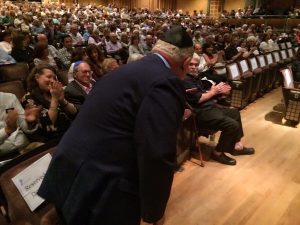A new display commemorating 317 Jewish war veterans from the Windsor area is more than just names on a wall.
In what may be one of the more unique tributes of its kind, the memorial takes many of those names and in an accompanying flat screen video slide show informs the public exactly what those veterans did during the war.
The plaque and video screen were unveiled Oct. 26 at an event leading up to Remembrance Day that also featured something else that’s exceptional: a story about a World War II Mexican diplomat who saved 40,000 Jews in France from the Nazis, an unknown hero even in his own country.
The Windsor area’s rich agricultural fields are home to a large Mexican migrant worker community, and in an effort to reach out, the local Mexican consul, Alberto Bernal Acero, contacted the Jewish community and offered a film about the little-known official named Gilberto Bosques.
During the dedication, Bill Mechanic, the man who came up with the memorial concept and did the bulk of the work putting the stories and 52-minute slide show together, said he got the idea after seeing his father, David’s, name, engraved on a RCAF memorial unveiled last year. “And I said to myself, ‘Why don’t we have something like this for our Jewish war veterans?’”
Some $10,000 was raised for the effort, which lists the veterans of wars going back to the Spanish American War and through to Vietnam, though the majority served in World War II.
READ: REMEMBERING CANADIAN JEWISH WAR VETERANS
Mechanic, a businessman, told the gathering of community members and dignitaries that for Jews, fighting in that war held additional meaning. They faced anti-Semitism on the streets and school yards of Windsor. But going overseas, “now they were fighting a different type of anti-Semitism: they were fighting Hitler and the Nazis.”
In an interview, Mechanic said that he and his 85-year-old aunt, Rosalie Lopatin, scoured records of various Jewish organizations, along with family contributions, to not only obtain the veterans’ names, but as much of their stories as possible.
Where there was sufficient information those names were uploaded to the video, which shows a 52-minute continuing loop of individual veterans’ photos and short descriptions of their wartime service. The video screen is located immediately above an engraved four-foot high monument in the Windsor Jewish Community Centre lobby.
“This had to be done now,” Mechanic said, since only three veterans of the war remain alive.
Mechanic was in awe as he described the stories he found, which few local community members are aware of. “Nobody’s seen any of this,” he said.
Some of the most well known individuals of the postwar generation – lawyers, businessmen, a city councillor – had dramatic, colourful personal stories that might make a movie action hero wilt.
Among them were people such as former Jewish community centre executive director Joe Eisenberg. “He stayed on in service after the war, kept going AWOL. He was finding displaced Jewish Holocaust survivors,” Mechanic said.
Or Abe Asner, a survivor of the Polish Radun Ghetto, who fled and spent four years in the resistance.
Or fishmonger Hy Goldberg, “a nice, sweet man,” who during the war drove jeeps and tanks and helped liberate Bergen Belsen. “We’ve got pictures of him and his jeep with 33 bullet holes – the guy was Rambo,” Mechanic said.
Meanwhile, those in attendance also saw the film Visa al Paraiso (Visa to Paradise) about the Mexican consul in Marseilles, France, who issued beleaguered Jews with Mexican visas.
“He [Bosques] saved as many people as Raoul Wallenberg,” current Jewish community centre executive director Jay Katz said. “So it’s really interesting. As happens in wartime, there are so many unsung heroes.”
This month, the centre is also hosting an exhibit, War Stories, featuring photographs of Jewish service men and women, a collection gathered from families, the Ontario Jewish Archives, and the Holocaust Memorial Museum in Washington, D.C.





